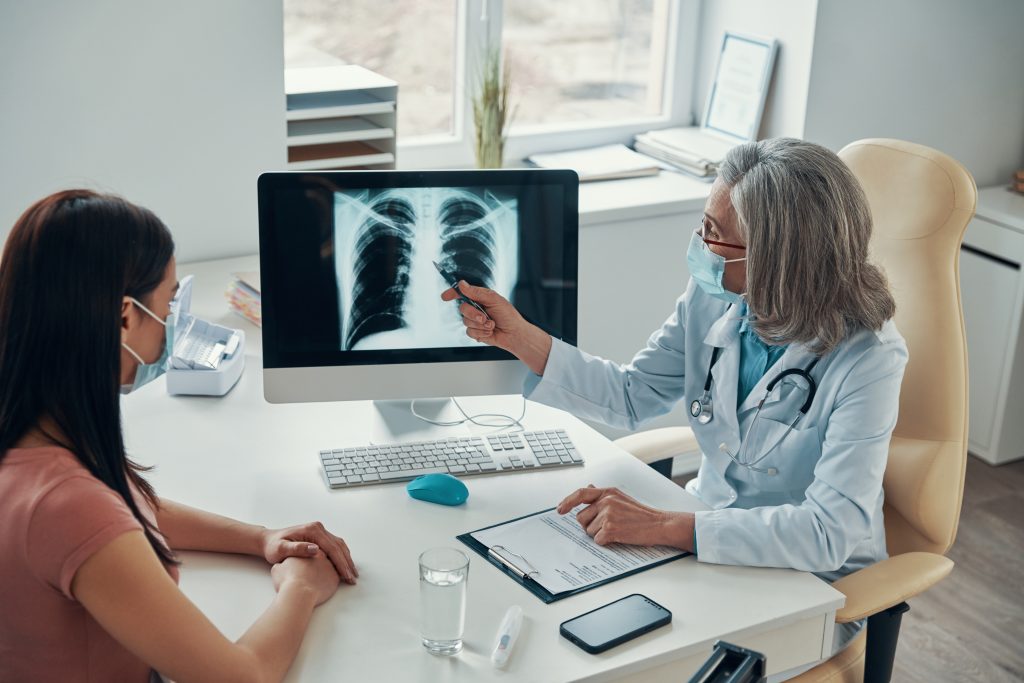Pulmonary Hypertension
Pulmonary hypertension is characterized by elevated blood pressure in the pulmonary artries, through which blood carrying low oxygen levels travels from the heart to the lungs. The initial indication of this condition is experiencing difficulty in breathing during regular activities. The primary factors contributing to this ailment include heart disease, lung disease, and lower oxygen levels in the body. Timely detection and treatment can greatly improve one’s overall well-being and enjoyment of life.

What causes pulmonary hypertension?
Pulmonary hypertension can be caused by various factors such as congenital heart disease, connective tissue disease, coronary artery disease, high blood pressure, liver disease, blood clots in the lungs, and chronic lung diseases like emphysema. Genetics also contribute to its development.
Pulmonary hypertension may occur alongside various other illnesses, including lung and heart disease. Heart failure is a frequent occurrence in individuals with pulmonary hypertension.
Symptoms of pulmonary hypertension
Signs of pulmonary hypertension consist of:
- shortness of breath
- tiredness
- feeling faint or dizzy
- chest pain (angina)
- a racing heartbeat (palpitations)
- In the legs, ankles, feet, or abdomen, there is an abnormal accumulation of fluid (oedema) that causes swelling.
Participation in physical activities may be hampered as the symptoms tend to deteriorate while exercising.
Types of pulmonary hypertension
The World Health Organization has categorized pulmonary hypertension into five groups.

PAH, also known as Group 1 pulmonary arterial hypertension,
PAH can be caused by various factors, including underlying medical conditions and specific medications. This condition leads to the narrowing, thickening, or stiffness of your pulmonary arteries, resulting in reduced blood flow and increased pressure within these arteries.
Group 2 pulmonary hypertension
Group 2 encompasses pulmonary hypertension (PH) caused by left heart disease. In this category of PH, the arteries and lungs are not as thick or rigid as those in WHO Group 1. However, there are issues with the contraction or relaxation of the heart, or problems with the valves on the left side of the heart. Consequently, the left side of the heart cannot adequately handle the blood flowing back from the lungs, resulting in a buildup of blood. This buildup increases the pressure in the lungs, causing PH. WHO Group 2 is the most prevalent type of PH.
Group 3 pulmonary hypertension
Some lung issues result in the constriction of the arteries within your lungs. This constriction reduces the amount of blood that can pass through your lungs, which in turn increases the pressure within your pulmonary arteries.
Group 4 pulmonary hypertension
Group 4 consists of pulmonary hypertension that is caused by the presence of blood clots in the lungs or by disorders that result in excessive clotting throughout the body.
Group 5 pulmonary hypertension
Group 5 encompasses cases where PH is not the primary concern but is linked to other illnesses in ways that are not fully comprehended. These related conditions may consist of sarcoidosis, sickle cell anemia, chronic hemolytic anemia, spleen removal, and specific metabolic disorders, among others.
Treatment

The treatment plan for pulmonary hypertension can differ from individual to individual, hence it will be tailor-made to meet your specific requirements. Consult your doctor to explore the available options and get a clear understanding of what you can anticipate.
Initially, your medical practitioner will focus on addressing the underlying cause of your ailment. For instance, if emphysema is identified as the culprit, steps need to be taken to manage this condition in order to enhance your pulmonary hypertension situation.
Additionally, many individuals seek medical intervention to enhance their respiratory function, facilitating their ability to engage in physical activities and complete everyday chores. Oxygen therapy, wherein pure oxygen is inhaled through specialized nasal prongs, proves beneficial in cases where breathlessness and low blood oxygen levels are present. This therapeutic method is particularly advantageous for individuals with pulmonary hypertension, prolonging their lifespan. If there is a risk of blood clot formation, physicians may prescribe blood thinners as a preventive measure. Moreover, other medications contribute to the improved functioning of the heart and prevent the accumulation of fluid in the body.
In cases of severe pulmonary hypertension, the doctor might recommend the use of calcium channel blockers as a treatment. These medications work to decrease blood pressure both in the lungs and throughout the rest of the body.
If calcium channel blockers are not sufficient, your doctor might direct you to a specialized treatment facility. More specific treatments may be required to widen your constricted blood vessels. These treatments can come in the form of pills, inhalable medications, or intravenous drugs. Possibilities comprise:
- The following pills are used to treat certain medical conditions: ambrisentan branded as Letairis, bosentan sold as Tracleer, macitentan known as Opsumit, riociguat marketed as Adempas, selexipag sold as Uptravi, sildenafil also known as Revatio, tadalafil branded as Adcirca, and treprostinil sold as Orenitram.
- Betydningene av inhalatorer: Iloprost trometamin (Ventavis), treprostinil (Tyvaso)
- Intravenous medications, such as epoprostenol sodium (sold as Flolan and Veletri) and treprostinil (known as Remodulin), are administered through the veins.
If the condition worsens or if medications are ineffective, your physician may suggest a transplantation of the lungs or a medical technique known as atrial septostomy. In atrial septostomy, a surgeon establishes a connection between the right and left sections of the heart. This surgical procedure can lead to significant adverse effects.
Making changes to your way of living can help enhance the symptoms you are experiencing.
- Stop smoking. You can seek advice from your healthcare provider on programs and products that can assist you.
- Adhere to a nutritious eating plan. Consume a range of fruits, veggies, and whole grains, as well as lean meat, poultry, fish, and low-fat or fat-free milk. Opt for a diet that is low in fat, cholesterol, sodium, and sugar.
- Monitoring your weight on a daily basis can enable you to stay mindful of any sudden increase, indicating a deterioration of your pulmonary hypertension condition.
- Keep yourself engaged and moving. Integrate activities like walking into your daily routine. Communicate with your healthcare provider about the intensity of your physical activity. Steer clear of overexertion or carrying excessive weight. Take breaks and relax whenever necessary.
- It is advisable to consult with a healthcare professional to determine whether hot tubs and saunas have any impact on your blood pressure before using them.
- Exercise caution when flying or visiting high-altitude areas as you might require additional oxygen. It is important to consult your healthcare provider about your travel arrangements.
Treatment in Türkiye:
The medical staff of surgical teams, doctors, and consultants at REHABTÜRK can provide the best treatment options and free consultations, striving to stay up-to-date on the latest medical technologies and methods.
